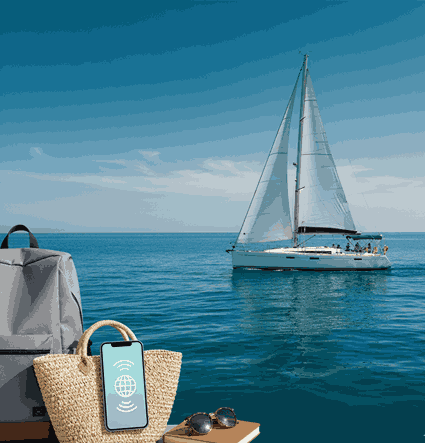Picture this: twinkling lights strung between medieval buildings, the scent of cinnamon and mulled wine in the air, and wooden stalls packed with handmade treasures. European Christmas markets transform shopping into pure magic.
- 2025-2026 Christmas Market Dates
- 1. Nuremberg, Germany
- Must-Try Food & Drinks at a German Christmas Market
- 2. Vienna, Austria
- Top Christmas Markets to Hit in Vienna
- 3. Strasbourg, France
- 4. Prague, Czech Republic
- Must-try foods at Prague Christmas markets
- 5. Bruges, Belgium
- Belgian Market Treats
- 6. Cologne, Germany
- The 7 Christmas Markets of Cologne
- 7. Tallinn, Estonia
- Estonian Specialties to try at the Christmas market
- 8. Budapest, Hungary
- Hungarian Winter Food
- 9. Copenhagen, Denmark
- Inside Tivoli during Christas
- Danish Christmas Flavors
- Tip
- 10. Salzburg, Austria
- Salzburg’s Market Scene
- 11. Dresden, Germany
- Must-Try Dresden Christmas food
- 12. Krakow, Poland
- Polish Christmas Foods
- 13. Basel, Switzerland
- 2 Markets, 2 Vibes:
- 14. Rovaniemi, Finland
- Santa Village Pricing Breakdown for season 2025-26
- 15. Colmar, France
- Six Markets of Colmar
- Alsatian Treats to Try at Colmar Christmas Market
- Tip
- 🎄 15 Best Christmas Markets in Europe 🎄
- ${market.city}
- Read more
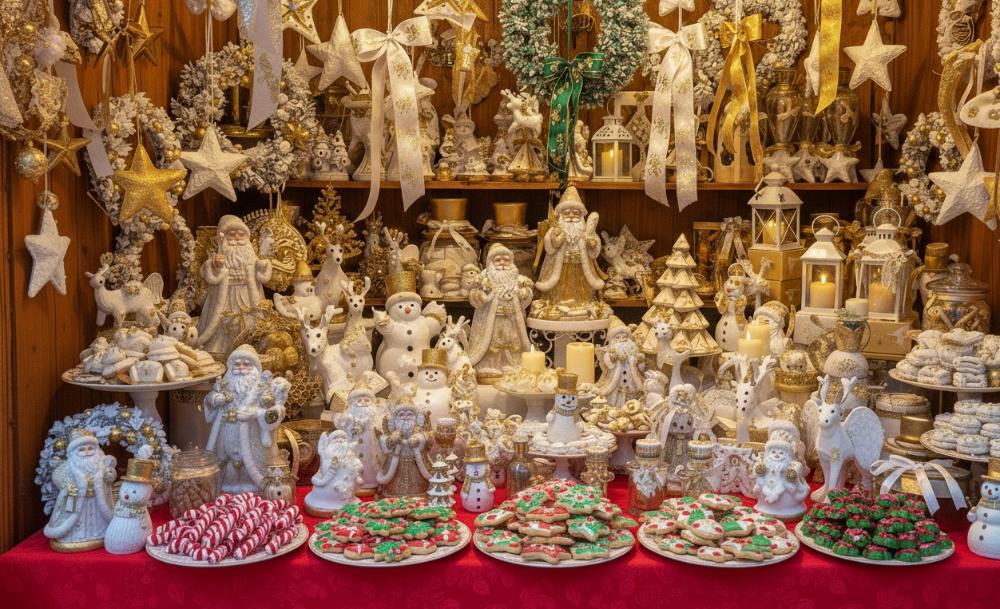
From late November through December, these markets transform historic squares into winter wonderlands. Each one has its own personality. Some go all-in on tradition, others surprise you with modern twists.
This guide covers the 15 best Christmas markets in Europe, complete with dates, prices, and insider tips to help you plan the perfect festive getaway.
2025-2026 Christmas Market Dates
| Market | Opening Date 2025 | Closing Date 2025 | Entry Fee |
|---|---|---|---|
| Nuremberg, Germany | Nov 28 | Dec 24 | Free |
| Vienna, Austria | Nov 15 | Dec 26 | Free |
| Strasbourg, France | Nov 28 | Dec 27 | Free |
| Prague, Czech Republic | Nov 29 | Jan 6, 2026 | Free |
| Bruges, Belgium | Nov 28 | Jan 1, 2026 | Free |
| Cologne, Germany | Nov 24 | Dec 23 | Free |
| Tallinn, Estonia | Nov 21 | Jan 7, 2026 | Free |
| Budapest, Hungary | Nov 14 | Jan 1, 2026 | Free |
| Copenhagen, Denmark | Nov 15 | Dec 31 | €15-20* |
| Salzburg, Austria | Nov 20 | Jan 1, 2026 | Free |
| Dresden, Germany | Nov 26 | Dec 24 | Free |
| Krakow, Poland | Nov 28 | Dec 26 | Free |
| Basel, Switzerland | Nov 27 | Dec 23 | Free |
| Rovaniemi, Finland | Dec 1 | Jan 6, 2026 | €10-30** |
| Colmar, France | Nov 21 | Dec 29 | Free |
1. Nuremberg, Germany
Nuremberg’s Christkindlesmarkt is the gold standard of German Christmas markets. It draws over 2 million visitors each year, sprawling across the Hauptmarkt square with 180 wooden stalls topped with red-and-white striped cloth.
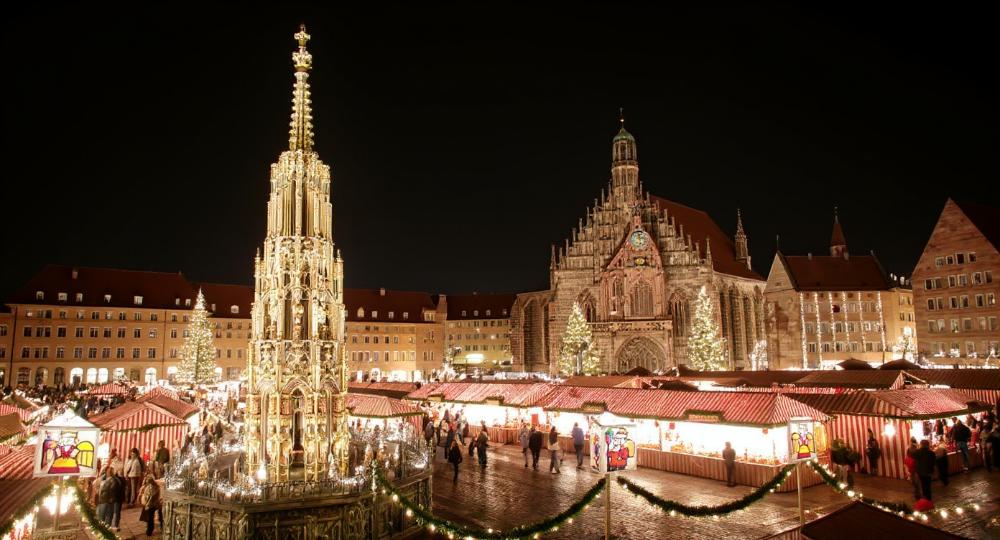
The opening ceremony features the Christkind (Christmas Angel) giving her prologue from the Church of Our Lady balcony. It’s spine-tingling stuff.
What to Buy:
- Zwetschgenmännle (prune people figures)
- Handcrafted ornaments from local artisans
- Traditional lebkuchen (gingerbread) in decorative tins
Must-Try Food & Drinks at a German Christmas Market
Nuremberg bratwurst comes three to a bun for €4-5. The local glühwein runs €4 plus €3 deposit for the commemorative mug. Skip the tourist spots near the fountain and head to the stalls on Fleischbrücke for shorter lines.
“The children’s market with its nostalgic carousel and steam train makes Nuremberg especially magical for families”
Best times to visit? Weekday mornings before 11 am or after 8 pm. Weekends get packed by noon.
2. Vienna, Austria
Vienna runs 20 Christmas markets across the city. But the showstopper is at Rathausplatz, where the City Hall becomes a glowing backdrop for 150 stalls.
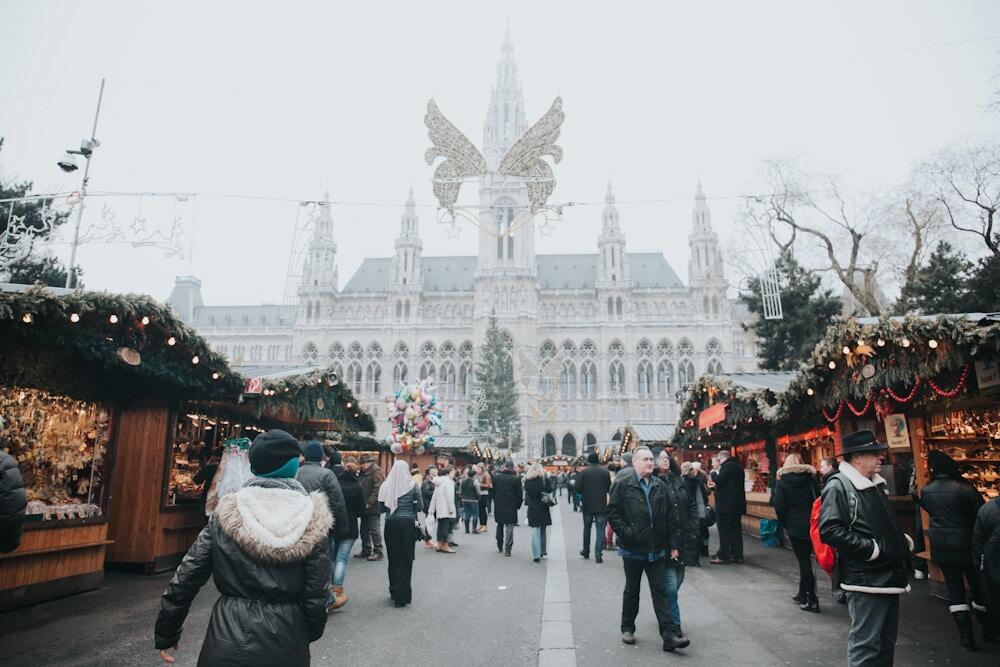
The Vienna markets date back to 1298, over 700 years of Christmas tradition. The Rathausplatz market alone welcomes 3 million visitors annually.
Top Christmas Markets to Hit in Vienna
- Rathausplatz: The main event with ice skating
- Schönbrunn Palace: Most romantic setting
- Belvedere Palace: Smaller, more intimate
- Karlsplatz: Focus on local artisans
The ice skating path at Rathausplatz winds through the park for 3,000 square meters. Entry costs €8, skate rental another €6. Pro tip: book online to skip the queue.
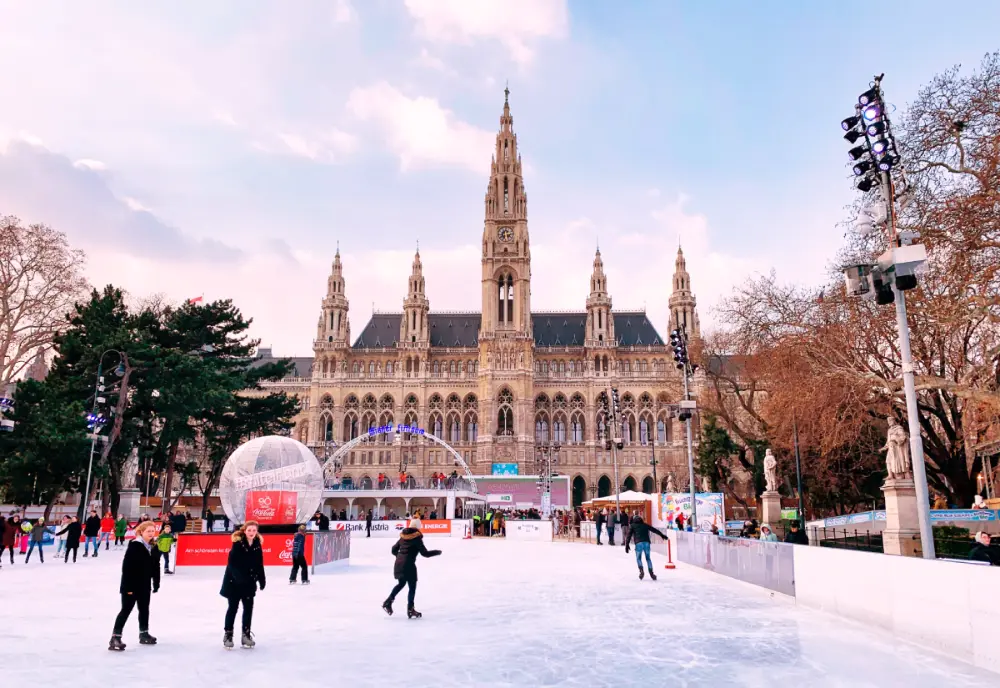
The food prices at Vienna’s Christmas markets are pretty average for Europe: a punch of glühwein (mulled wine) around €5, a raclette sandwich from €7 to €9, and a traditional kaiserschmarrn (shredded pancake) starts at €6.
Best photo spot? The elevated terrace at Rathausplatz gives you the whole market spread out below with the illuminated City Hall.
3. Strasbourg, France
Strasbourg calls itself the “Capital of Christmas” and honestly? Fair claim. This market has been running since 1570, making it one of Europe’s oldest.
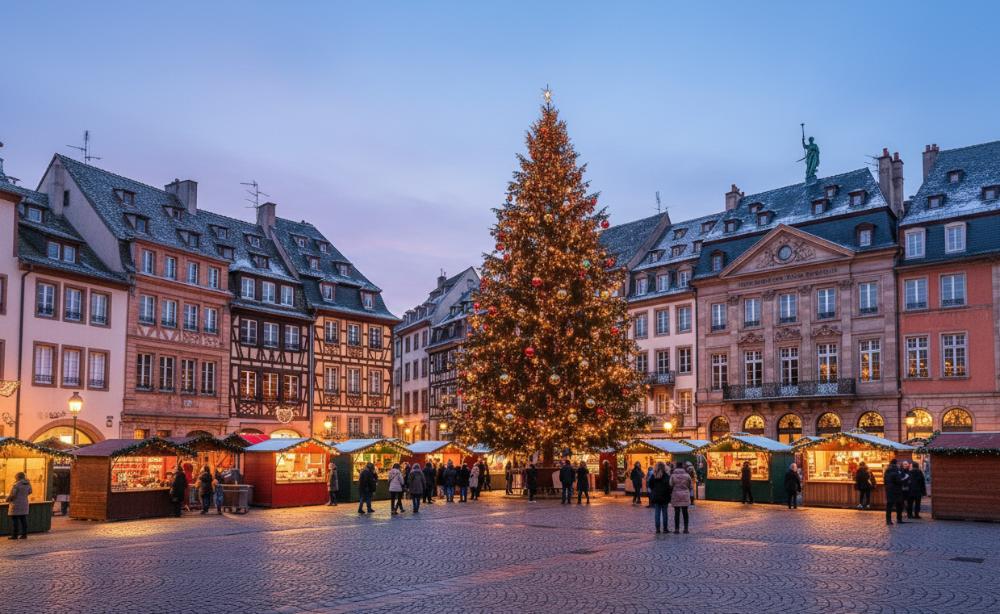
300 chalets spread across 12 locations throughout the city. The Grande Île (historic center) becomes one massive Christmas village. Place Kléber hosts the famous 30-meter Christmas tree.
Market Locations & Specialties:
| Location | Focus | Must-See |
|---|---|---|
| Place de la Cathédrale | Traditional crafts | Cathedral light show (every 15 min) |
| Place Kléber | Main tree & ice rink | Giant Christmas tree |
| Petite France | Alsatian products | Half-timbered houses lit up |
| Place Grimmerod | Alternative gifts | Local designers |
Bredele cookies are the local Christmas specialty – tiny butter cookies in dozens of flavors. Buy them by weight (€12-15/kg) at Maison Naegel or Christian bakeries.
The cathedral light show runs every evening from 5 pm – 10 pm. Get there 20 minutes early for a good viewing spot.
4. Prague, Czech Republic
Prague’s Christmas markets run longer than almost any other – from late November through Epiphany. The Old Town Square market draws 600,000 visitors during the season.
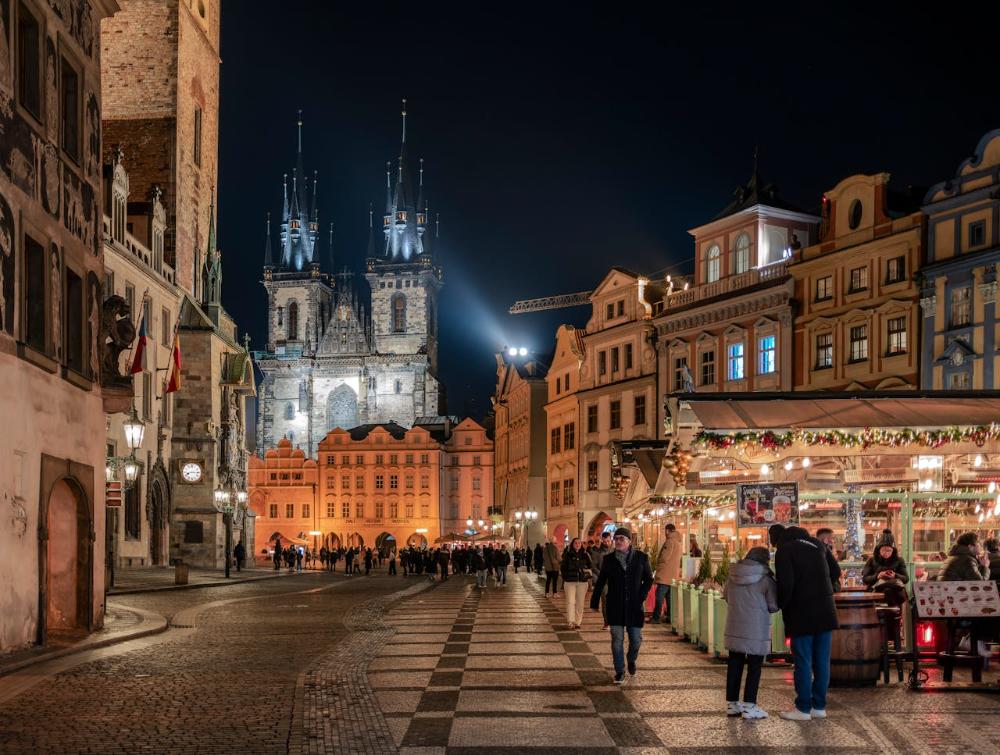
The massive Christmas tree (usually 25 meters tall) arrives from the Krkonoše Mountains. They light it at 4:30 pm on the first Saturday of Advent with free concerts.
Prague’s Christmas markets are spread across several squares, each with its own character. Old Town Square is the main draw, with more than 70 stalls creating a lively atmosphere.
Wenceslas Square feels more commercial and often offers better prices. Republic Square focuses heavily on food, while Kampa Island is quieter, known for artisan crafts and a more relaxed setting.
Must-try foods at Prague Christmas markets
- Trdelník (chimney cake): 60-80 CZK (€2.50-3.50)
- Svařák (mulled wine): 40-60 CZK (€1.50-2.50)
- Prague ham: 150-200 CZK (€6-8)
- Medovina (hot honey wine): 50-70 CZK (€2-3)
Street food hack: the sausages at Wenceslas Square cost half what they do at Old Town Square. Same quality, fewer tourists.
Best time for photos? Blue hour (4-5 pm), when the lights come on, but there’s still color in the sky.
5. Bruges, Belgium
Bruges in winter feels like stepping into a snow globe – even when there’s no snow. The medieval center becomes even more fairytale during the Christmas market season.
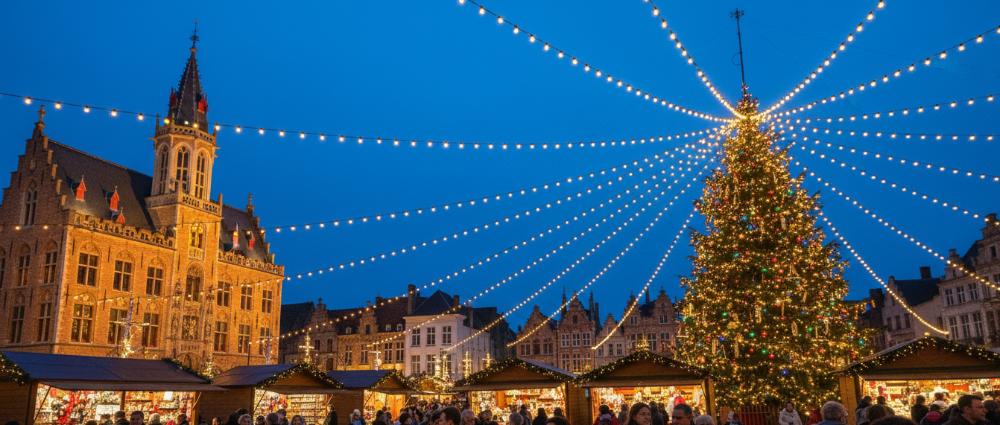
The main market fills Grote Markt square with 40 wooden chalets. But here’s what makes Bruges special: the ice rink on the square, surrounded by guild houses from the 1400s.
In Bruges, winter comes with plenty of cozy things to do. Ice skating at the city rink costs €6, with skates available to rent for €4. Horse-drawn carriage rides through the cobbled streets are a classic experience, priced at €50 for 30 minutes.
Belgian Market Treats
| Belgian waffles | €3-5 | Chez Albert stall |
| Chocolate-covered strawberries | €4-6 | Various stalls |
| Jenever (gin) tasting | €3-5/shot | Corner of the market |
| Smoutebollen (dough balls) | €4-6 | Corner of market |
You can also hop on a heated canal boat tour for €12 to see the city from the water. And if you’re a chocolate fan, The Chocolate Line offers a walking tour that’s free with purchases.
The Chocolate Line (Simon Stevinplein 19) stays open late during market season. Their hot chocolate costs €5, but it’s basically melted chocolate bars. Worth every cent.
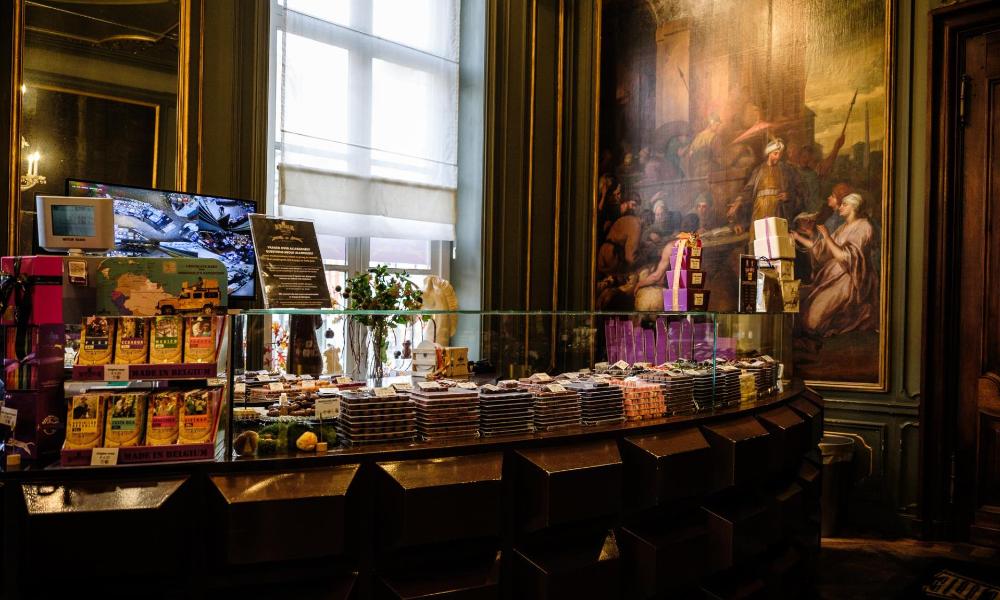
Skip weekend evenings unless you love crowds. Wednesday afternoons are perfect – locals shopping, minimal tour groups.
6. Cologne, Germany
Cologne goes big with seven different Christmas markets. Each has its own theme, from traditional to maritime. The cathedral market (at the Dom) is the star, with 160 stalls and 5 million visitors.
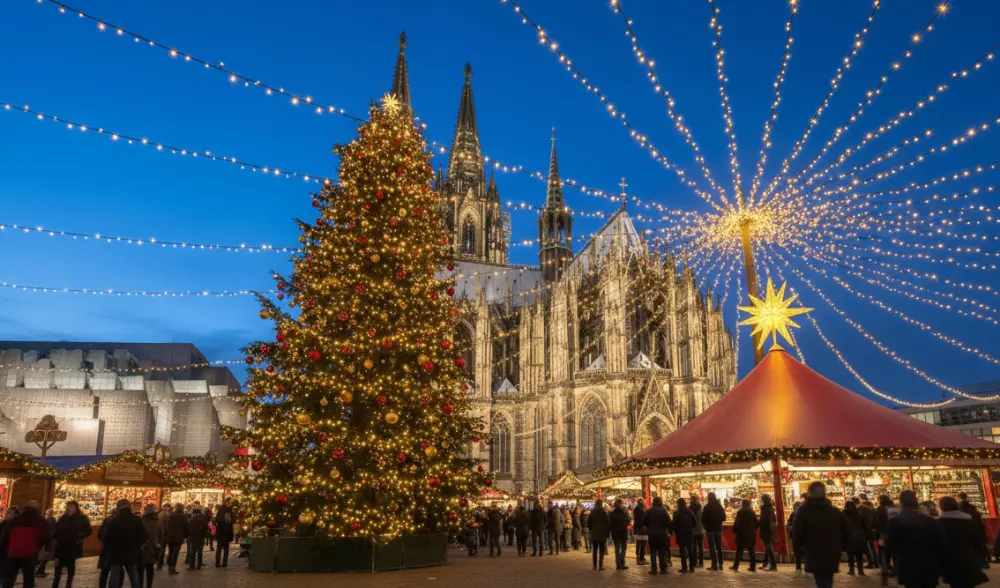
Cologne’s markets generate over €130 million in revenue. The city takes Christmas seriously.
The 7 Christmas Markets of Cologne
- Cathedral Market: Classic, biggest, beneath the UNESCO cathedral
- Old Town (Alter Markt): Traditional, good for families
- Neumarkt: Modern, young crowd, live music
- Rudolfplatz: Village atmosphere, locals’ favorite
- Stadtgarten: Fairy tale theme for kids
- Harbour Market: Maritime Christmas theme
- Angel’s Market: LGBTQ+ friendly, Neumarkt area
Feuerzangenbowle (fire tongs punch) is Cologne’s signature winter drink. Watch them set sugar cones on fire over the punch bowl. €5-6 per mug, and yes, it’s strong.
“The Cathedral Market’s location, directly beneath the UNESCO World Heritage cathedral, creates one of Europe’s most atmospheric Christmas settings”
Best strategy? Start at the Cathedral, walk to Alter Markt (10 min), then Neumarkt (5 min). Three markets in one evening, easy.
7. Tallinn, Estonia
Tallinn’s Christmas market might be small (50 stalls), but the setting is unbeatable. The Town Hall Square, surrounded by merchant houses from the 1400s, looks straight out of a medieval painting.
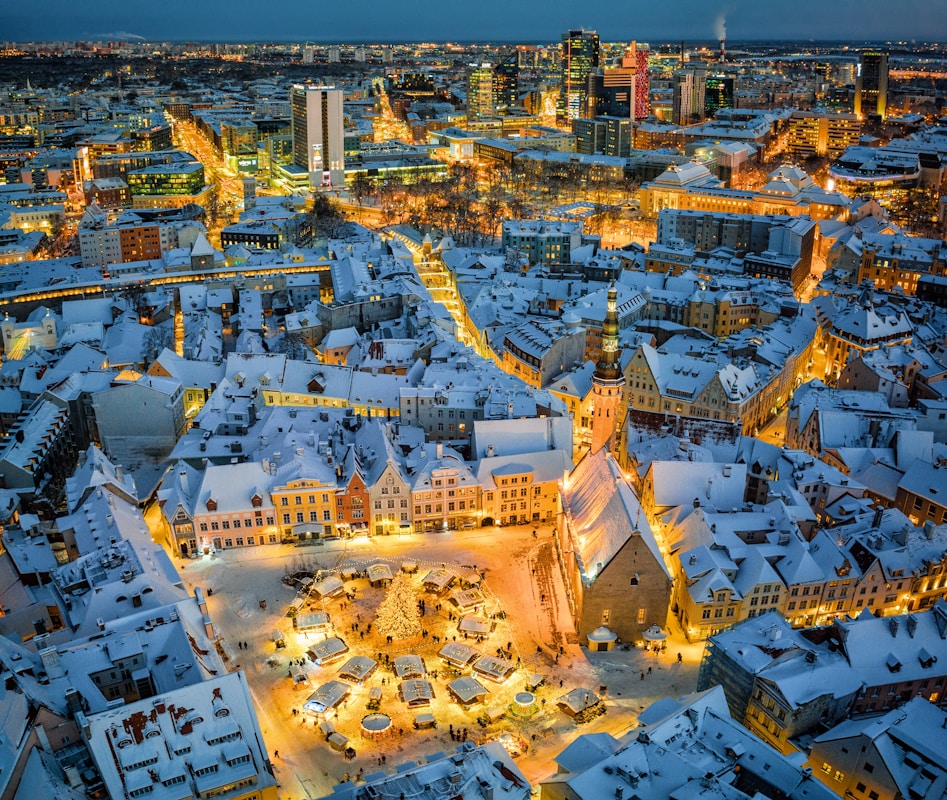
This market claims to have hosted Europe’s first public Christmas tree in 1441. True or not, the tradition runs deep. The current tree gets decorated with 500 meters of lights.
Estonian Specialties to try at the Christmas market
- Verivorst (blood sausage): €4-5
- Sauerkraut stew: €5-6
- Piparkook (gingerbread): €2-4
- Glögi (Estonian mulled wine): €3-4
The market stays open until January 7 for Orthodox Christmas. Post-New Year is actually perfect: fewer crowds, same atmosphere, hotel prices drop 40%.
Black pudding might sound scary, but try it. The Estonian version with lingonberry sauce and sour cream hits different on a cold day.
8. Budapest, Hungary
Budapest’s Christmas market at Vörösmarty Square combines Austrian-style tradition with Hungarian flair. Think goulash in bread bowls next to classical Christmas stalls.
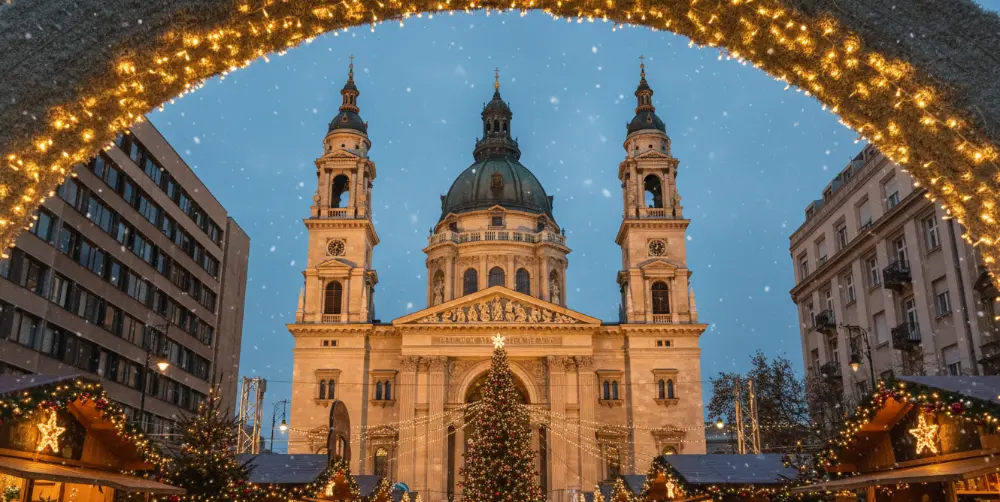
St. Stephen’s Basilica hosts a second market with Hungary’s biggest Advent calendar projected onto the basilica facade. The 3D light show runs every 30 minutes from 4:30 pm-10 pm. Free to watch.
Hungarian Winter Food
- Lángos (fried dough): 1,500-2,500 HUF (€4-6)
- Kürtőskalács (chimney cake): 1,000-1,500 HUF (€2.50-4)
- Goulash soup: 1,800-2,200 HUF (€4.50-5.50)
- Forralt bor (mulled wine): 800-1,200 HUF (€2-3)
Shopping at the Budapest Christmas Market is all about local flavors and handmade crafts. You’ll find paprika in decorative bags for around 1,500 HUF (≈ €4) and hand-painted eggs ranging from 2,000–5,000 HUF (≈ €5–13).
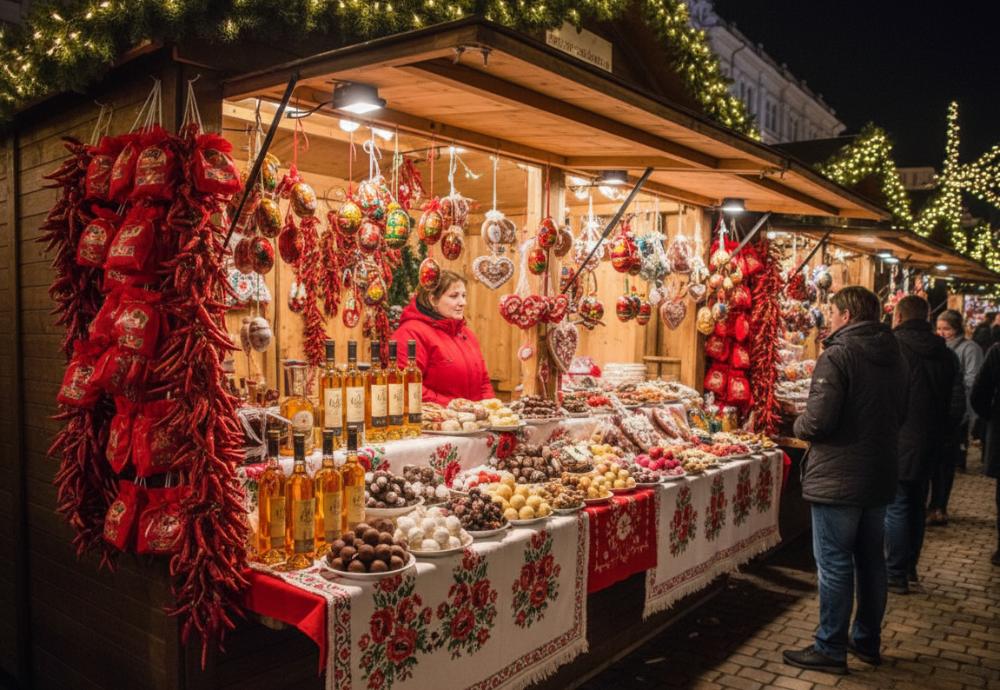
Embroidered textiles make for beautiful souvenirs, typically priced between 3,000–8,000 HUF (≈ €8–21). And for something tasty to take home, Tokaji dessert wine costs about 2,500–4,000 HUF (≈ €7–11).
Combine the markets with a thermal bath visit. Széchenyi Baths stay open until 10pm. Nothing beats soaking in 38°C water while snow falls. Entry from 8,900 HUF (€22).
9. Copenhagen, Denmark
Tivoli Gardens transforms into a Nordic wonderland with 1,000 Christmas trees, 5 kilometers of garland, and enough lights to see from space (not really, but almost).
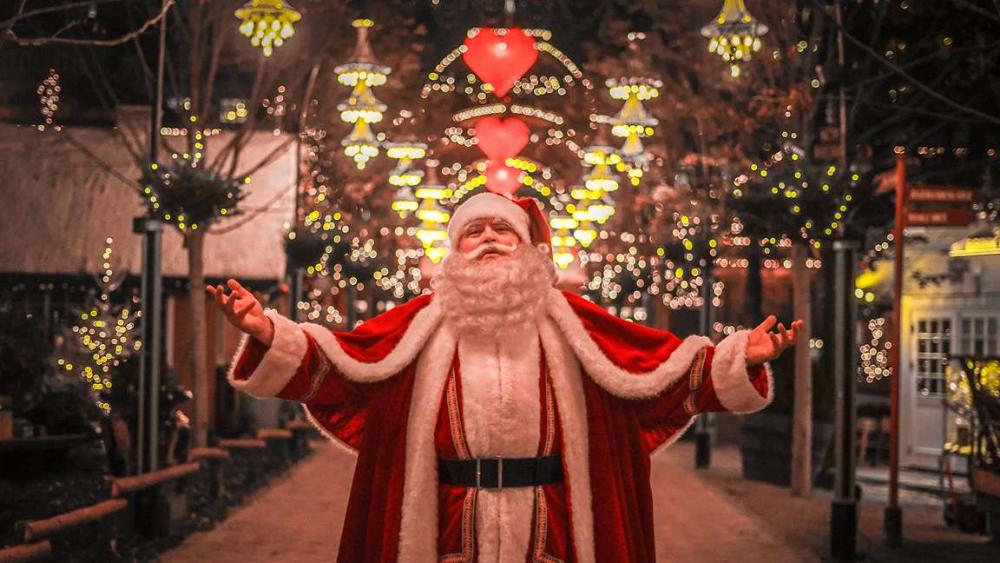
Tivoli’s Christmas season attracts over 1 million visitors. The separate entrance fee (120-160 DKK/€15-20) keeps it less chaotic than free markets.
Inside Tivoli during Christas
- 60+ stalls along the main paths
- 30+ rides operating (extra cost)
- Daily “snowfall” at closing time
- Nutcracker ballet at the Peacock Theatre
Danish Christmas Flavors
At Copenhagen’s Christmas markets, food is part of the experience. Æbleskiver, the traditional pancake balls, cost around 45–60 DKK (≈ €6–8) and are best enjoyed with jam and powdered sugar. A cup of gløgg, Denmark’s version of mulled wine, is 50–70 DKK (≈ €7–9) and usually comes with almonds and raisins.
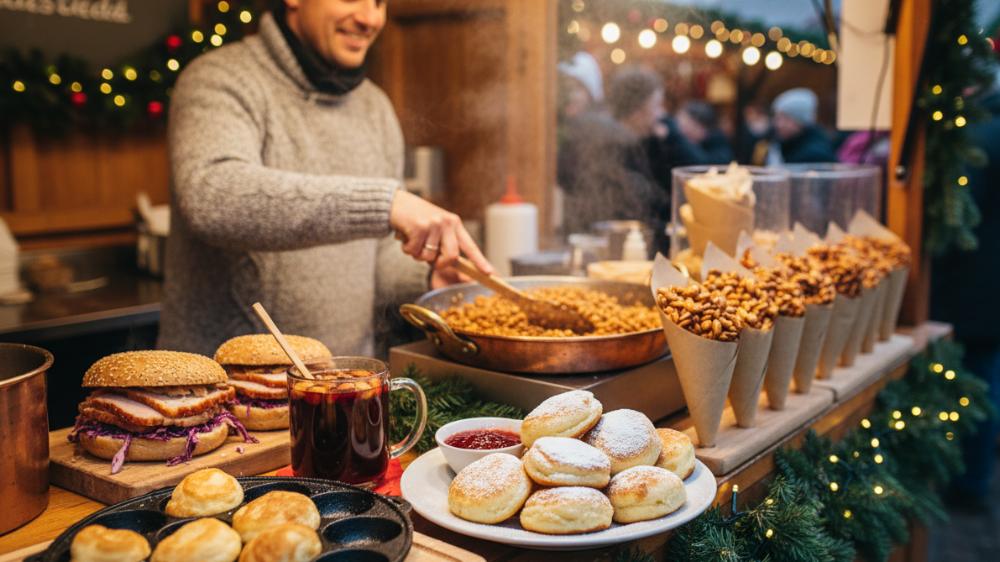
For something heartier, try a flæskesteg sandwich with pork and red cabbage, priced at 85–110 DKK (≈ €11–15). And don’t miss brændte mandler, warm roasted almonds sold in paper cones for 40–60 DKK (≈ €5–8).
Tip
Book Tivoli tickets online to save 20 DKK. Friday nights have fireworks at 9:45 pm during the Christmas season.
The Christmas market at Nyhavn (free entry) offers a more local experience. Smaller, cheaper, right on the canal with the colored houses as a backdrop.
10. Salzburg, Austria
Salzburg pairs Christmas markets with Mozart and The Sound of Music. The main market at Cathedral Square (Domplatz) dates back to the 15th century.
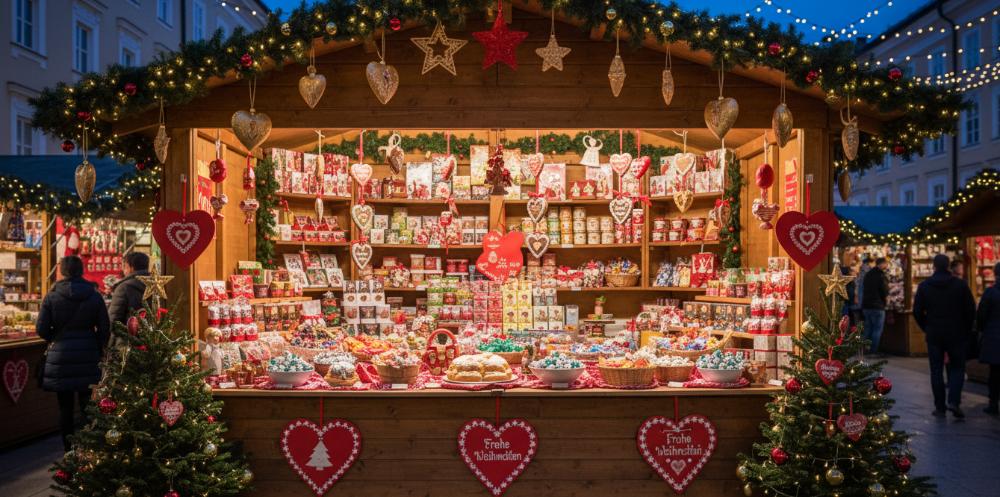
Salzburg ranks among Austria’s most authentic markets. Around 100 exhibitors focus on traditional crafts over mass-produced items.
Salzburg’s Market Scene
- Domplatz: Main traditional market
- Mirabell Square: Smaller, locals-oriented
- Hohensalzburg Fortress: Weekends only, best views
- Hellbrunn Palace: Family focus, weekends
- Sternadvent: Alternative crafts at Sternbräu
“The Salzburg Advent Singing performances at the Great Festival Hall are as much a part of Christmas here as the markets themselves”
Fortress market requires a funicular ride (€13 round trip) but you get the city spread below. Go at sunset. The 20-minute golden hour up there beats any restaurant view.
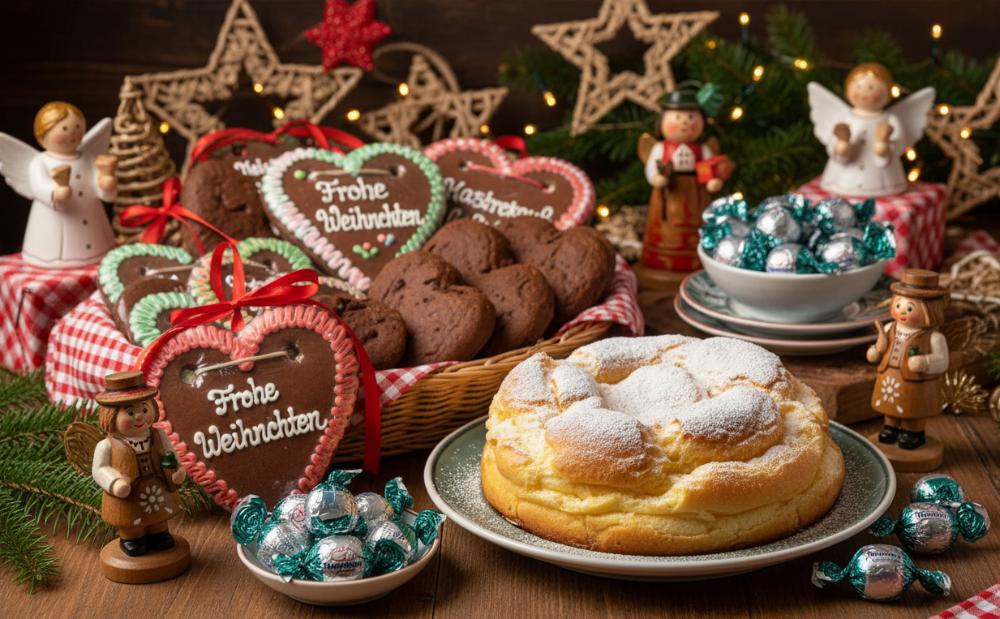
Local Specialties:
- Mozartkugel chocolates: €1.50-2 each
- Lebkuchen hearts: €8-15
- Rauchenmandl (incense smokers): €15-30
- Salzburger Nockerl: €12-14 (restaurant dessert)
11. Dresden, Germany
Dresden’s Striezelmarkt is Germany’s oldest documented Christmas market, dating to 1434. The name comes from Striezel, the local word for Stollen (fruit bread).
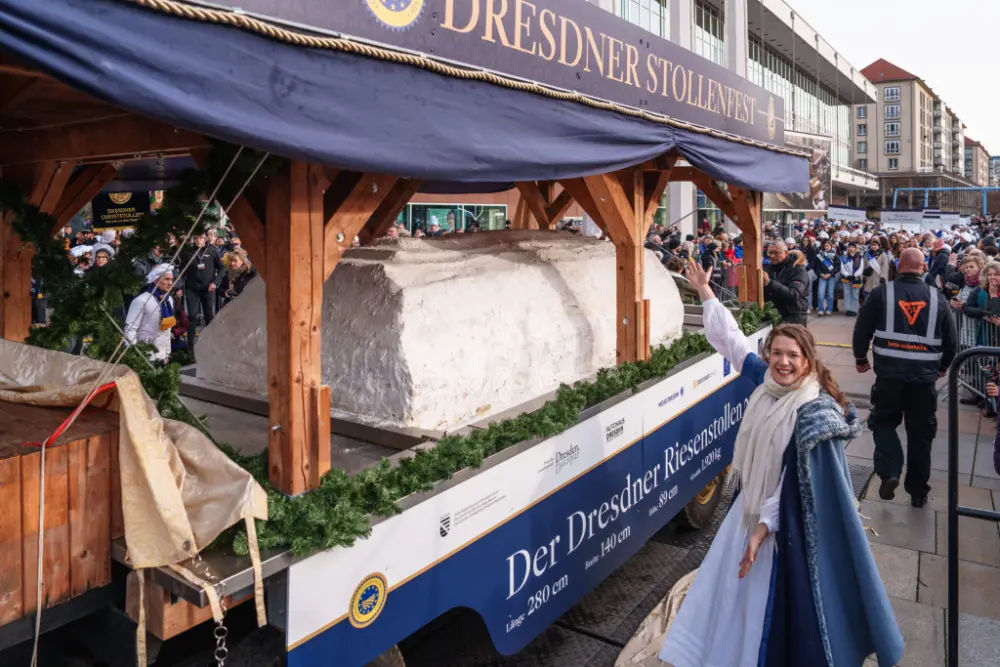
This market does one thing nobody else does: the Stollenfest. Every second Saturday of Advent, they parade a 3-4 ton giant Stollen through the city, then slice it with a 1.6-meter knife. Slices sell for €5, proceeds to charity.
Dresden’s Christmas market is one of the largest in Germany, with more than 240 stalls to explore. It attracts around 3 million visitors each year, adding to its festive buzz.
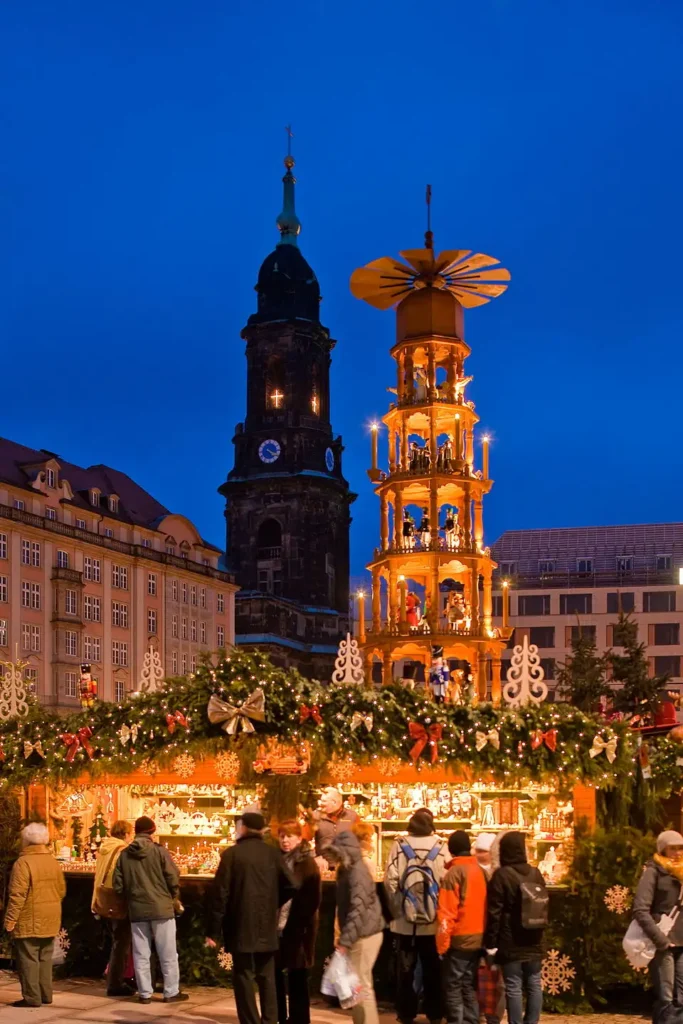
A highlight is the 14-meter Christmas pyramid, the tallest of its kind in the world. The town hall also features a giant Advent calendar, standing 10 meters high.
The pyramid (Weihnachtspyramide) actually rotates. Kids can ride the lower level for €2. Instagram gold at blue hour.
Must-Try Dresden Christmas food
- Original Dresdner Stollen: €8-15 per loaf
- Pulsnitzer gingerbread: €4-8
- Glühwein in souvenir mug: €5 + €3 deposit
- Bratwurst: €4-5
Pflaumentoffel (prune chimney sweep figures) are Dresden’s quirky Christmas mascot. They bring good luck. Handmade ones run €10-25.
12. Krakow, Poland
Krakow’s Main Market Square (Rynek Główny) is Europe’s largest medieval square. During Christmas, 80 wooden huts fill the space without making it feel crowded.
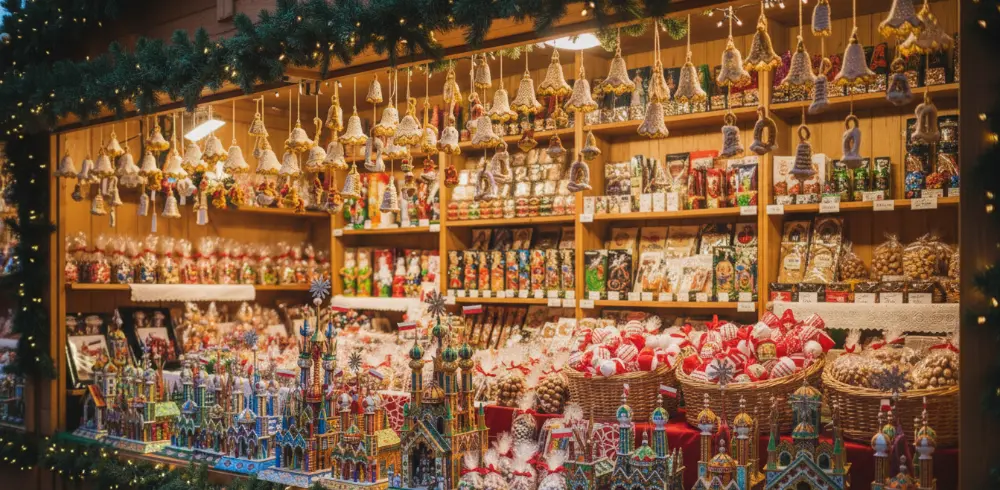
Polish Christmas markets focus more on crafts than other countries. Real amber jewelry, hand-carved wooden toys, and painted pottery dominate the stalls. Prices? About 40% less than Western European markets.
Polish Christmas Foods
- Oscypek (smoked sheep cheese): 15-20 PLN (€3-4)
- Kielbasa sausage: 20-25 PLN (€4-5)
- Pierogi (6 pieces): 20-30 PLN (€4-6)
- Grzaniec (mulled wine): 12-15 PLN (€2.50-3)
St. Mary’s Basilica plays the hejnał (bugle call) every hour. The Christmas Eve tradition stops mid-note, commemorating a 13th-century trumpeter shot by invaders. Adds drama to your market visit.
Cloth Hall (Sukiennice) in the square center houses permanent craft stalls. Heated, same goods, 20% cheaper than outside stalls.
13. Basel, Switzerland
Basel hosts Switzerland’s largest Christmas market with 190 stalls. Split between Barfüsserplatz and Münsterplatz, connected by a twinkling path through the old town.
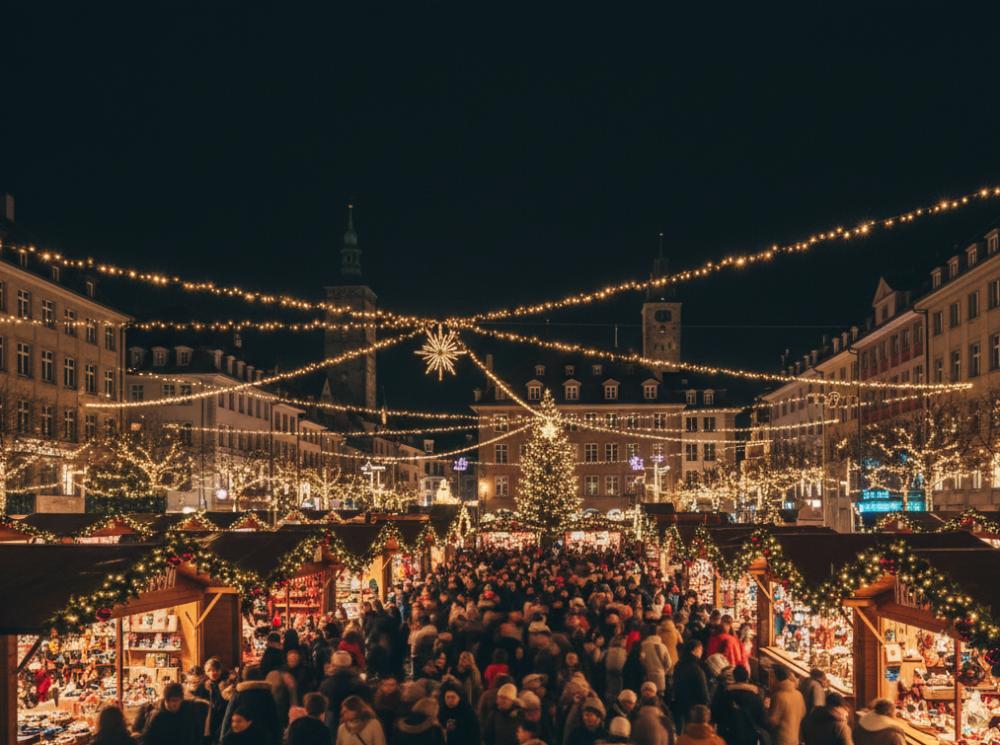
Swiss precision meets Christmas charm here. Every stall looks identical (by design), creating perfect symmetry. But inside each one? Everything from Swiss watches to Himalayan crafts.
2 Markets, 2 Vibes:
- Barfüsserplatz: Traditional Swiss focus, 120 stalls
- Münsterplatz: International crafts, 70 stalls
At Swiss Christmas markets, prices vary depending on the treat or souvenir. A portion of raclette costs about 12–15 CHF (€13–16), while a cup of glühwein is 6–8 CHF (€6.50–8.50). Swiss chocolate bars are usually 8–12 CHF (€8.50–13). For gifts, handmade ornaments range from 15–40 CHF (€16–43).
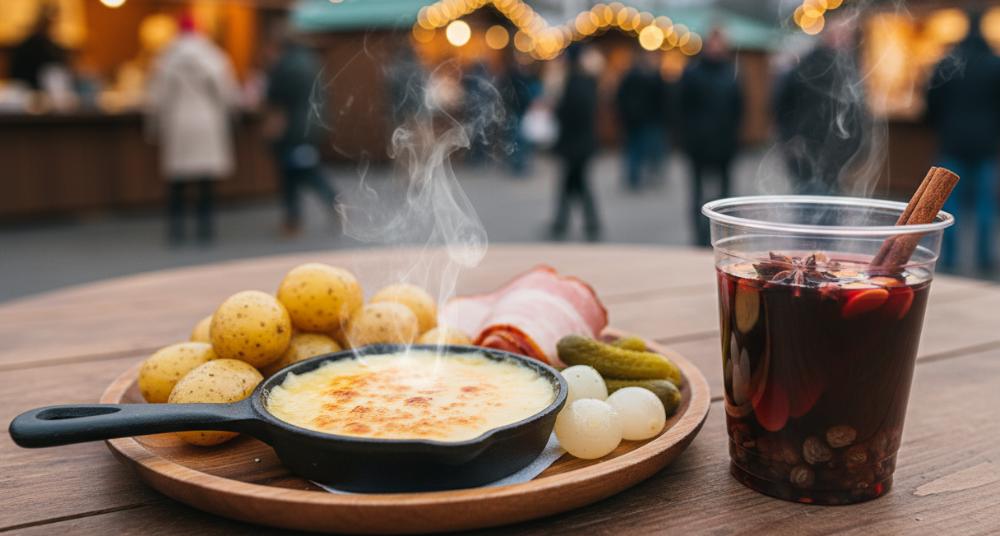
Yes, it’s Switzerland. Yes, it’s expensive. But quality matches the price. That €16 raclette comes as a full meal with potatoes and pickles.
Free workshops run daily: cookie decorating, wreath making, candle dipping. Sign up at the information booth by 2 pm for evening sessions.
14. Rovaniemi, Finland
This is it — Santa’s official hometown. The Arctic Circle runs right through Santa Claus Village. You can stand with one foot in the Arctic at the marked line.
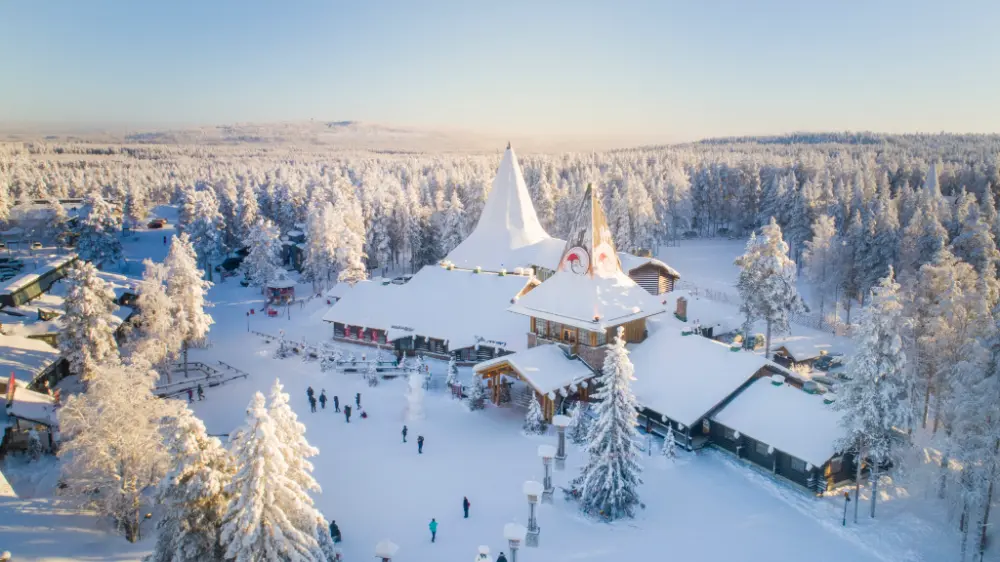
500,000 visitors come here annually. Santa works every single day of the year. Meeting him is free, and photos cost €40-75.
Santa Village Pricing Breakdown for season 2025-26
| Meet Santa | Free (photos €40+) |
| Reindeer sleigh rides | €35-150 |
| Husky sledding | €119-169 |
| Snowmobile safaris | €99-189 |
| Northern lights tours | €89-129 |
| Reindeer leather goods | €30-200 |
| Kuksa wooden cups | €25-60 |
| Finnish knives | €50-300 |
| Northern lights photography | €60-150 |
Mrs. Santa’s Cottage serves the best gingerbread (€4) north of the Arctic Circle. The post office processes 500,000 letters to Santa yearly. Send one with the special Arctic Circle postmark (€2).
Northern lights season peaks in December-March. Book Aurora alerts through your hotel. They’ll wake you if the lights appear.
15. Colmar, France
Colmar spreads its Christmas magic across six different markets throughout the old town. Half-timbered houses, canal reflections, and thousands of lights create pure storybook scenes.
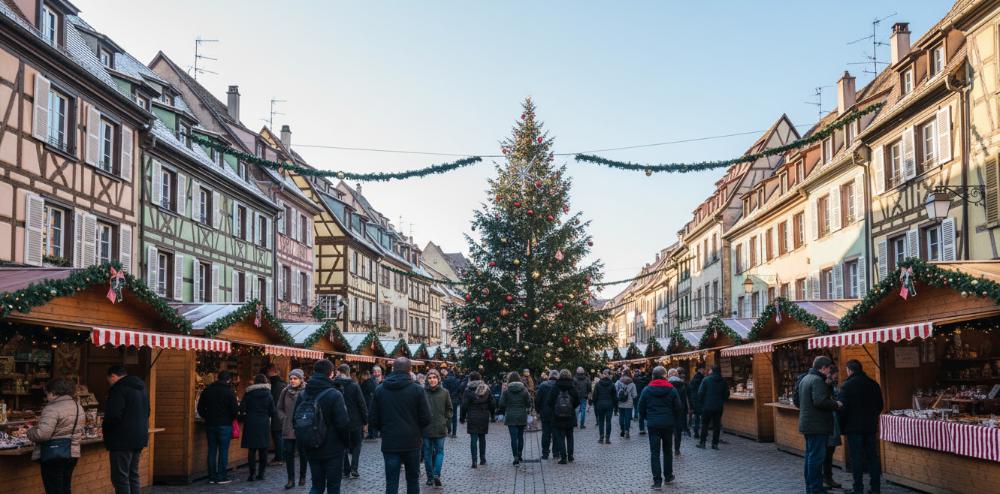
The Little Venice district gets special treatment – illuminated boat rides (€6) through the canals past decorated bridges. Looks fake, it’s so perfect. But it’s real.
Six Markets of Colmar
| Location | Theme | Highlights |
|---|---|---|
| Place des Dominicains | Traditional | Inside church venue |
| Place Jeanne d’Arc | Children’s | Carousel, toy stalls |
| Place de l’Ancienne Douane | Artisan | Local craftwork |
| Koïfhus | Antiques | Vintage treasures |
| Marché Couvert | Gourmet | Regional foods |
| Little Venice | Romantic | Canal boats, wine |
Alsatian Treats to Try at Colmar Christmas Market
Place des Dominicains market sits INSIDE a church. Stained glass windows, plus Christmas lights, equal a photography paradise. Free entry, but donations appreciated.
- Mannele (sweet bread men): €2-3
- Berawecka (fruit bread): €8-12
- Vin chaud blanc (white mulled wine): €3-4
- Munster cheese sandwich: €6-7
Tip
Book dinner reservations now. Seriously. Every winstub (wine tavern) fills by November for December dinners.
Planning a European Christmas market trip? Start with geography. Vienna-Salzburg-Munich makes an easy train triangle. Prague-Dresden-Berlin works too. Or go all-in with a Rhine River cruise, hitting 5-6 markets.
🎄 15 Best Christmas Markets in Europe 🎄
Click any card for details • Filter by month below
Book hotels by October for December trips. Prices jump 50% after Halloween. Best overall timing? First two weeks of December. Full atmosphere, manageable crowds.

